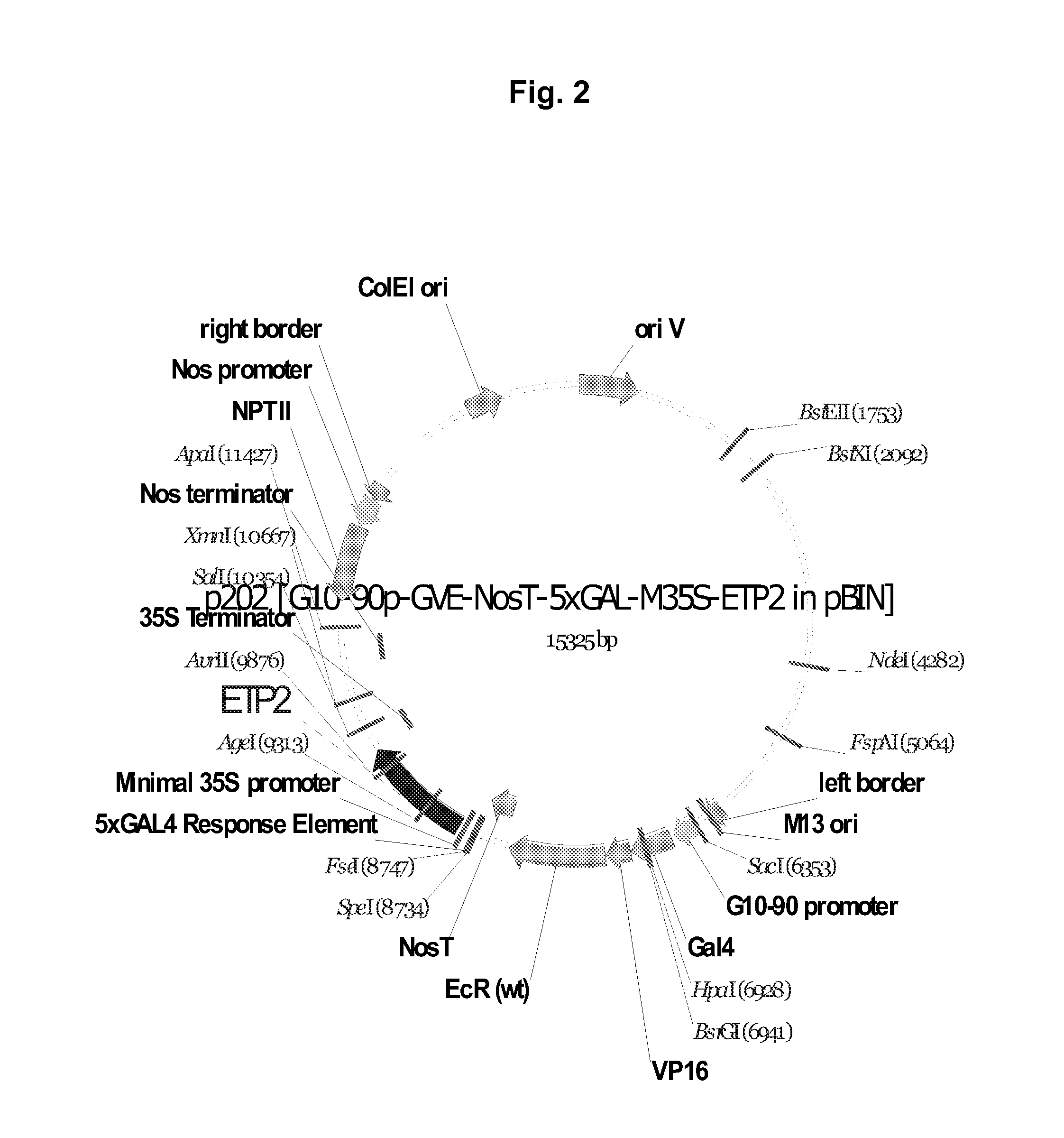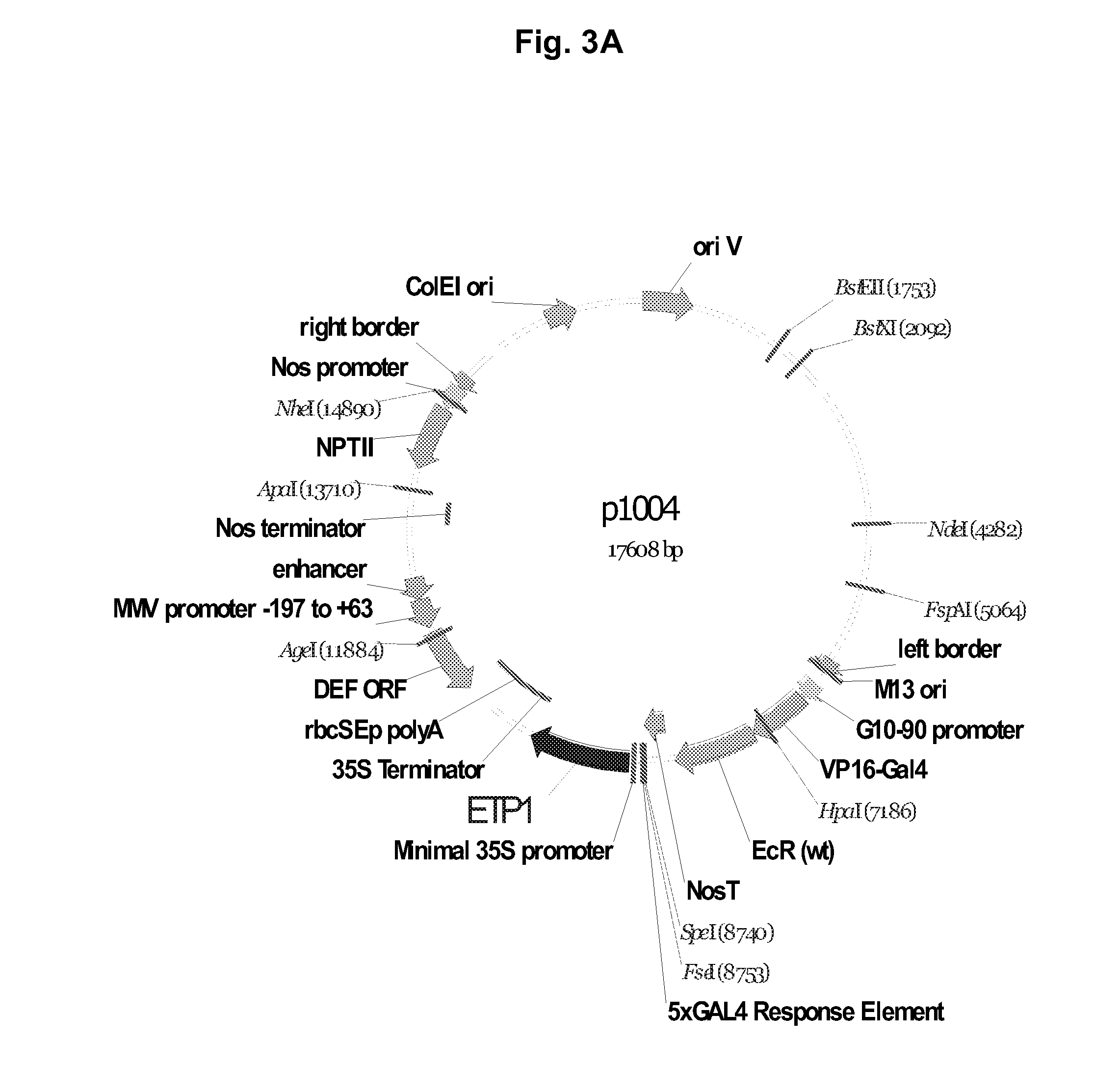Control of targeted turnover of key ethylene hormone signaling pathway proteins to modulate ethylene sensitivity in plants
a technology of ethylene hormone and signaling pathway, which is applied in the field of control of targeted turnover of key ethylene hormone signaling pathway proteins to modulate ethylene sensitivity in plants, can solve the problems of increased ethylene insensitivity of plants, low induction level, toxic or volatile inducers, etc., and achieves reliably and safely controlled ethylene sensitivity regulation, tight gene expression regulation, and the effect of tight regulation
- Summary
- Abstract
- Description
- Claims
- Application Information
AI Technical Summary
Benefits of technology
Problems solved by technology
Method used
Image
Examples
example 1
Plasmids
[0102]The gene cassette components, which are individually cloned, include for the activation cassette:[0103]the G 10-90 constitutive promoter,[0104]the VP16 activation domain,[0105]the GAL4 DNA binding domain, and[0106]an ecdysone receptor ligand binding domain associated with the NOS terminator[0107]sequence.
[0108]Similarly, the target cassette components are individually cloned, including[0109]the inducible promoter which consists of five copies of the GAL4 response element and the minimal 35S promoter, and[0110]the ETP1 gene (GENBANK Ace. No. NM 112874) or the ETP2 gene (GENBANK Acc. No. NM 112777) and[0111]the 35S terminator sequence. All individual sequences are identified by nucleotide numbers in SEQ ID NO: 1 described below.
[0112]In assembling the activation cassettes, the following components are fused in two different orders to make two different activation cassettes:
[0113]VP16 AD to GAL4 LBD to EcR(DEF) of DBD (abbreviated “VGE”) and
[0114]GAL4 LBD to VP16 AD to E...
example 2
Production of Transgenic Arabidopsis Plants
[0124]Arabidopsis plants are transformed with plasmids from Example 1 with Agrobacterium using the standard floral dip protocol. Seed is harvested and plated onto kanamycin containing media. Transformed plants are selected for ability to grow on kanamycin and screened by PCR to confirm presence of the ETP1 or ETP2 genes. Positive transformants are selfed to produce T1 seed. Seed is grown on kanamycin containing media to identify lines homozygous for the transgenes. Homozygous plants are used to test for induction of ethylene insensitivity.
example 3
Effect of Modulation of Ethylene Sensitivity on Arabidopsis Plant Growth
[0125]A triple response assay (Guzman and Ecker, 1990 cited above, modified as described below) is used to determine the modulation of ethylene sensitivity in the transformed Arabidopsis plants of Example 2. Wild-type, ein2-5 (an ethylene insensitive mutant control) and p1004 or p1005 Arabidopsis transformant seedlings are assayed. Arabidopsis seed is surface-sterilized and imbibed in 20 μM inducer in the dark for 4 days at 4° C. The seed is plated on 0.5× MS with 1% sucrose and 20 μM inducer with and without 20 μM ACC (the precursor of ethylene) and grown in the dark for 4-8 days at 21° C. In some experiments, 5 μM AgNO3 (an inhibitor of ethylene that induces ethylene insensitivity) is added to the media as a control. The response to ethylene is scored on the last day. The transgenic plants containing the activation and target cassettes for expression of ETP1 or ETP2 in the presence of inducer demonstrate eth...
PUM
| Property | Measurement | Unit |
|---|---|---|
| concentration | aaaaa | aaaaa |
| population density | aaaaa | aaaaa |
| resistance | aaaaa | aaaaa |
Abstract
Description
Claims
Application Information
 Login to View More
Login to View More - R&D
- Intellectual Property
- Life Sciences
- Materials
- Tech Scout
- Unparalleled Data Quality
- Higher Quality Content
- 60% Fewer Hallucinations
Browse by: Latest US Patents, China's latest patents, Technical Efficacy Thesaurus, Application Domain, Technology Topic, Popular Technical Reports.
© 2025 PatSnap. All rights reserved.Legal|Privacy policy|Modern Slavery Act Transparency Statement|Sitemap|About US| Contact US: help@patsnap.com



